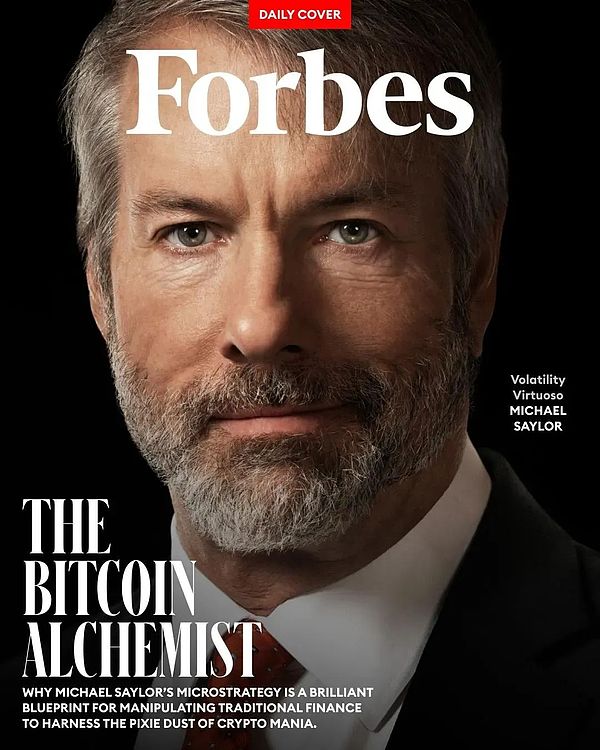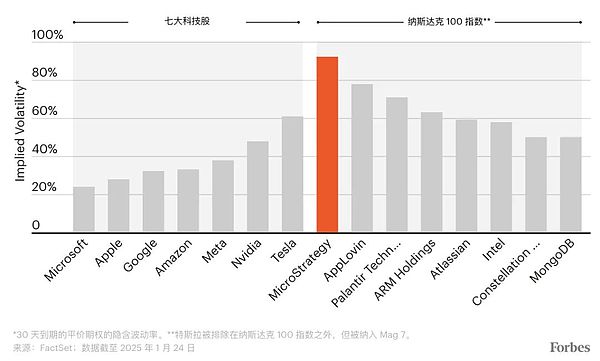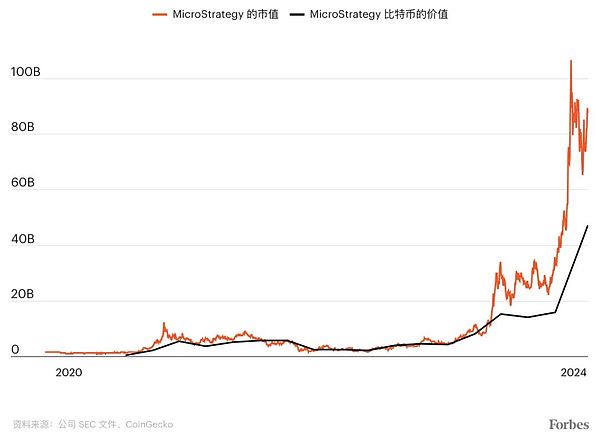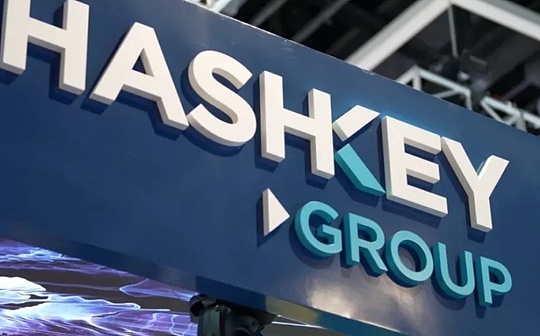
Source: Nina Bambysheva Forbes
MicroStrategy is not only a huge Bitcoin bet, but also a corporate financing revolution.
Most people think that Billionaire Michael Saylor’s publicly traded company MicroStrategy is a huge and risky bet on Bitcoin.But a closer look reveals that this is a masterpiece, a blueprint for manipulating traditional finance to leverage the magical dust that drives cryptocurrency fanaticism.
New Year’s Eve at Villa Wikia is a gorgeous scene of orange and gold, a scene taken directly from Fitzgerald’s most gorgeous fantasy.More than 500 people crowded on the manicured lawn of the century-old house, whose Versailles-style banquet hall has hosted Margaret Thatcher, Henry Kissinger and Mikhail GorbachevWaiting for celebrities.
Bitcoin’s recent breakthrough of $100,000 (rather than the arrival of 2025) is the real reason for this feast.The waiter walked around with champagne from the silver tray, with the ubiquitous B-printed appetizers, and the dancer in a golden tights waving glittering orange orbs, paying homage to the iconic tone of Bitcoin.A huge card is vaguely visible in the middle of the garden, and the king’s face is replaced by a cheeky B-word.

The water party continues on the Usher number.The 154-foot superyacht, which appeared in the 2015 film Star Partner, shines in the Miami skyline.Shuttle buses are flowing endlessly, carrying Bitcoin executives, opinion leaders, and most importantly institutional investors, all wearing “Bitcoin Fashion Outfits” (orange suits, B logo accessories).Two giant projectors play clips predicting Bitcoin will rise to millions, while a DJ wearing a space helmet directs a bass-heavy track among swaying palm trees.
“I’m a little tired of winning,” quipped a reveler wearing a black hat with Satoshi Nakamoto’s face.Everyone attending the party has cryptocurrency reputation: The person wearing the Satoshi hat is David Bailey, the 34-year-old CEO of BTC Inc. and the publisher of Bitcoin magazine, who hosted in JulyAt the Bitcoin Conference, Donald Trump vowed to make the United States “the cryptocurrency capital of the earth” and establish a national Bitcoin reserve.
Michael Saylor, the owner and host of Villa Vecchia, is 59, who is hiking in a carnival in his signature black blazer, blue jeans and a T-shirt (with B. printed on the front).among the crowd.He kindly accepted people’s handshakes and selfies requests.Here, Bitcoin is God, and Cylor is its prophet.
Cryptocurrency is like a second rebirth for Sailer, because he made more than $10 billion in profits during the initial Internet bubble.At that time, after graduating from MIT in 1989, he co-founded MicroStrategy, a software company based in Tysons Point, Virginia.The company initially engaged in data mining and business intelligence software businesses, but later clashed with the Securities and Exchange Commission due to accounting practices.In 2000, the company paid a fine, reached a settlement with the federal government, and republished results for previous years.
Over the next two decades, MicroStrategy’s sales performance was mediocre, with a market value hovering around $1 billion.All this changed in 2020, when Sailer decided to make Bitcoin the core strategy of MicroStrategy.
Last year, the price of cryptocurrencies soared after the SEC approved Bitcoin ETFs from giants such as BlackRock and Fidelity, more than doubled in 12 months and exceeded $100,000 in early December.Just before Christmas, MicroStrategy joined the Nasdaq 100, spurring more demand for its stock, which rose more than 700% last year as it issues bonds and accumulates more bitcoins (it now has 471107indivual).Sailer’s company is now the largest holder of digital assets, second only to the elusive Satoshi Nakamoto, who is said to hold 1 million bitcoins.During 2024, Sailer’s net worth jumped from $1.9 billion to $7.6 billion.A month into the new year, his net worth reached $9.4 billion.
MicroStrategy’s amazing earnings have sparked dissatisfaction among critics and short sellers who cannot understand why a small software company that holds only $48 billion in Bitcoin has a market value of $84 billion.But what Sailer’s critics don’t understand is that MicroStrategy cleverly spans two areas: one is bound by traditional financial rules, where companies issue debt and stocks, bought and sold by hedge funds, traders and other institutions; the other is faithful,Ruled by firm believers, they believe that Bitcoin will bring you a better world.
The driving force behind MicroStrategy’s success is embracing and fostering volatility, a distinctive feature of its core assets.Volatility is a natural enemy of traditional investors, but a close friend of option traders, hedge funds and retail speculators, making MicroStrategy one of the most active stocks on the market.Although its annual revenue is relatively small, at only $496 million, daily trading volume is comparable to the seven major tech giants (Meta, Apple, Alphabet, Microsoft, Amazon, Tesla and Nvidia).
“People think it’s crazy,” Saylor said. “How could a company like this small have such high liquidity? It’s because we put an crypto reactor in the middle of the company, attract capital, and then rotate it. This makesIncreased stock volatility has made our options and convertible bonds the most interesting and best performing products on the market.”
Michael Saylor is 100% correct about the popularity of the $7.3 billion convertible bonds issued by the company since 2021.Every minute of the trading day, MicroStrategy’s share price is amplified in real time due to the constant fluctuations of Bitcoin, increasing the implicit volatility of call options inherent in its convertible bonds.This is because unlike ordinary bonds, convertible bonds provide security for debt holders who have the option to convert their bonds into MicroStrategy stock at a pre-priced price before maturity.Every trader trained in Black-Scholes option pricing formulas knows that high implied volatility increases the value of options.As a result, Sailer was able to issue convertible bonds without paying interest costs.
So far, the six convertible bonds issued by MicroStrategy have maturity dates ranging from 2027 to 2032, with interest rates ranging from 0% to 2.25%.In the open bond market, liquidity has been shrinking due to the boom of private credit, and institutional investors are eager to get excess returns.MicroStrategy’s bonds are not only one of the only ways for large investors such as German insurance companies Allianz and State Street to invest in digital assets, but also one of the best-performing bonds on the market, with a return of more than 250% since its issuance.Even MicroStrategy issued a $3 billion five-year bond in November with a face rate of 0% and a exercise price of $672 (80% higher than MicroStrategy’s current share price), and it also rose 89% in just a few months.
Volatility is vitality
Here are three words posted on Twitter last March by MicroStrategy co-founder Michael Saylor, revealing the magic bullet that drives its stocks and bonds to perform well: the implicit volatility of corporate options, while volatility ratesIt is powered by the Bitcoin he has accumulated.Many traders are eager for volatility, and they expect MicroStrategy’s stock price to fluctuate by more than 90% in the next month, while Tesla and Amazon have volatility of 60% and 30% respectively.

Sailer understands that institutional investors who measure performance on quarterly benchmarks will continue to buy his risky stocks in order to improve portfolio returns.Issuing large quantities of convertible bonds like MicroStrategy usually dilutes corporate stocks, but in this case, convertible bonds have a bullish effect because these bonds represent future demand for stocks with increasingly high prices.Through secondary issuance and convertible bond issuance, MicroStrategy’s outstanding shares have increased from 97 million shares to 246 million shares since 2020.During the same period, its stock price rose 2666%.At the end of January, its shareholders voted to significantly increase the company’s authorized shares to 10.3 billion shares.This cycle runs itself: issuing billions of low-cost or no-cost debt and stocks, pushing up the price of Bitcoin through massive purchases, and driving large fluctuations in MicroStrategy’s stock.Repeatedly.
“They discovered a currency loophole in the financial market and exploited it,” exclaimed Richard Byworth, a former convertible bond trader at Nomura Securities and managing partner at Syz Capital, an alternative investment firm in Zurich, Switzerland.
It is understandable that Sailer has made no secret of his admiration for Bitcoin.Last August, he invented a brand new financial indicator called Bitcoin Yield or BTC Yield.This “return rate” has nothing to do with any revenue generated, but only measures the percentage of the proportion of Bitcoin held by a company to the company’s completely diluted stock over time.His initial goal was to grow 4% to 8% per year, but data released by MicroStrategy in January showed that Bitcoin yields in the fourth quarter were 48% and 74.3% for the full year of 2024 — although these figures are very large.But it makes no sense, he gives these numbers to his followers who worship him like bait.
Ben Werkman, a former commercial banker, consultant and early investor in the company’s Bitcoin strategy, said trying to value MicroStrategy with the old-fashioned approach will only make you lose your mind.Sailer “turned off his profit and loss thinking and said ‘We want to start with the company’s net assets and focus on leveraging our strengths on the balance sheet’, in which case it means buying more bitcoins.”
That’s exactly what MicroStrategy is doing.In October, Sailler announced a plan called “21/21” to raise up to $42 billion in the next three years (half through equity and half through debt) to buy more Bitcoin.In November and December alone, the company acquired nearly 200,000 Bitcoins worth about $18 billion.
As long as the price of Bitcoin continues to rise, it will all go very well, but what if Bitcoin collapses like it has been many times before?
“Scale is everything, because liquidity is everything. MicroStrategy is the singlest source of liquidity for trading Bitcoin-related risks, including spot and options markets, which are more important.”
Unless the end of the world really comes, MicroStrategy shouldn’t have any problems.Bitcoin needs to fall more than 80% from its current level of over $100,000 and last for at least two years before MicroStrategy can’t afford to repay its current debt.Sailer once again demonstrates his talent in leveraging capital markets and bond investor behavior.
MicroStrategy’s $7 billion debt is unsecured, and technically, no bitcoin in its funding pool can be used as a guarantee.In addition, based on the company’s current share price of $373, its debt of more than $4 billion is already “worth the money”, or in fact, it is already equity.
“In fact, there is very little debt on MicroStrategy’s balance sheet,” said Jeff Park, head of alpha strategy at San Francisco-based crypto asset management firm Bitwise. MicroStrategy’s Bitcoin holdings are unlikely to be forced to liquidate because institutional bond holdings are held.Some people have a high tolerance for refinancing, even in the worst case scenario.
What prevents other companies from resuming Bitcoin financial engineering?There is nothing.Many companies have begun to follow suit.According to Park, Bitwise counts about 90 listed companies, including well-known companies such as Tesla and Block, which have included Bitcoin on their balance sheets.In March, his company will launch the Bitwise Bitcoin Standard Corporate ETF, which will contain a weighted index of 35 listed companies holding at least 1,000 Bitcoins (about $100 million).MicroStrategy will dominate the index.
The imitators are providing ammunition to opponents of MicroStrategy.Miami-based investment firm Kerrisdale Capital released a short report on the stock in March, which said MicroStrategy shares represent a rare and unique way to acquire Bitcoin, but this situation is long gone.But Park believes that like Netflix in the streaming space, MicroStrategy’s first-mover advantage and scale set it apart.
“Scale is everything, because liquidity is everything. Whether it is the spot market or the option market, they are the most liquid source of risk associated with trading Bitcoin,” Park said. “MicroStrategy’s options market is by far the deepest global market in the world.Single Name Options Market.” MicroStrategy’s fanatical options even gave birth to a fund called the YieldMax MSTR Option Income Strategy ETF, which generates revenue by selling call options.The annual yield of the fund that was established for one year is 106%, and it has accumulated US$1.9 billion in assets.
Sitting by the pool at the Wikia Villa, his three parrots, Hodl, Satoshi and Max, chattering behind him, Saylor disdains the critics.”The traditional business wisdom over the past 40 years believes that capital is a liability and volatility is bad. The Bitcoin standard stipulates that capital is an asset and volatility is a good thing – this is its characteristic,” he insists. “They live in it.”In a flat world, a pre-Copernicus era. We were sitting on a 60-mph train, rotating a gyroscope carrying 30 tons of objects on it, while the rest of the world stood on the track,Not moving.”
This is not the first time Michael Sealer has flew close to the sun.
Born in 1965 at an air force base in Lincoln, Nebraska, he was immersed in military discipline in his early years.His father was a chief sergeant, and his family traveled between air bases around the world, and finally settled near Wright Patterson, Ohio, the location of Wright Brothers Aviation School.
He entered MIT to study aviation and aerospace with a full scholarship from the Air Force Reserve Officer Training Corps and wrote a computer simulation paper on the Italian Renaissance city-state.In his spare time, he likes to play guitar in a rock band and also drives a glider.He graduated with highest honors in 1987 and was appointed Second Lieutenant of the Air Force, but his fighter pilot dream was stranded by a heart murmur, which turned out to be a misdiagnosis.
When 1 + 1 = 3, MicroStrategy’s market value has increased 60 times in 4 years even when the Bitcoin price is sluggish.

At the age of 24, he co-founded MicroStrategy with Sanju Bansal, a member of the MIT fraternity.At the time, few people understood the potential of data analytics, and the company was the first to enter this field.With the help of the Internet boom, the company went public in 1998 and by 2000, its market value soared to more than $24 billion.Sailer’s net worth peaked at nearly $14 billion, and he became a tech evangelist who predicted a world where data would flow like water.“We will use our technology to eliminate the entire supply chain,” Saylor told Forbes magazine in late 1998. “We try our best to win a permanent victory across the entire global industry.”
Then the company collapsed.On March 10, 2000, MicroStrategy’s share price peaked at $313 per share, more than 60 times higher than the price of an IPO.Two weeks later, the company announced that it needed to recap its financial results, and the stock price plummeted to $72.The Securities and Exchange Commission accused Sailer and others of accounting fraud, and MicroStrategy later settled the charges for $11 million.Within two years, the company’s share price fell below $1.Sailer’s $13 billion wealth evaporated.
“This is the darkest moment in my life, and it’s terrible when people lose money because they trust you,” he said.
In 2020, after the government implemented quantitative easing policies for many years and invested trillions of dollars in COVID-19 stimulus measures, Sailer firmly believed that the remaining $530 million in cash and short-term investment on MicroStrategy’s balance sheet would be best used to invest in bits.currency.The U.S. government can print dollars at will — and it is working to do it — but Bitcoin’s design has a hard cap: the number of Bitcoins will never exceed 21 million.
If the price of Bitcoin plummets, the decline in MicroStrategy’s stock price will be more severe and faster than Bitcoin itself.But don’t ignore Cylor because he’s too smart.Many other companies have followed MicroStrategy, which now calls itself “the world’s first and largest Bitcoin Treasury Department.”
Some listed companies, such as Metaplanet, even rely on Bitcoin to survive.The Tokyo-based hotel chain faces an existential crisis during the pandemic, when Japan closed its borders to tourists.The small hotelier sold nine of its 10 hotels and issued shares and bonds to buy hotels for $70 million in Bitcoin.Metaplanet’s shares, traded on the Tokyo Stock Exchange and OTC markets, rose 2,600% in 2024, and its market value is currently $1 billion despite holdings of only $183 million.The company’s homepage now says “Use Bitcoin to protect the future” and there is almost no mention of hotels.”We are very grateful to Michael Sailer for creating a business plan for us to follow the world,” said Simon Gerovich, CEO of Metaplanet, a guest at Sailer’s New Year’s party.
“I invented 20 things and tried to make them successful, but none of them changed the world. Satoshi Nakamoto created something, gave it to the world, and then disappeared. It made me more successful than every idea I had.”
While many companies are unlikely to go to extremes like Metaplanet, there will certainly be more and more holders of Bitcoin.In January, the U.S. Financial Accounting Standards Board revised a rule that previously allowed companies to record a decline in cryptocurrency value as a loss in their quarterly reports, while holding cryptocurrencies will now be priced at market value, allowing for a simultaneous profit and loss hedging.For MicroStrategy, which lobbies for the rules to be revised, this could mean profits in several quarters in the coming year and potentially be included in the S&P 500.
According to YCharts data, hundreds of large listed companies around the world today hold more than twice the cash they currently need for operations and liabilities.The most famous of these is Berkshire Hathaway, which currently holds $320 billion in cash.
Given the $35 trillion (and still growing) national debt, Seyler’s mantra has been “cash is garbage.””Financial suppression is an eternal phenomenon,” Bitwise’s Park insists, an inevitable result of the government’s lower interest rates.We live in a world with highly developed finances, and the real economy and financial economy are basically out of touch.You can’t actually pay off your debt without printing more money.If you think you have to keep printing more money, then you’d better believe that the yield curve will be suppressed.
In Sailer’s view, Villa Wikia itself is the best example.The 18,000-square-foot mansion on Miami’s “Millionaire Street” was built in 1928 for the president of F.W. Woolworth.Sailer bought the house for $13 million in 2012.”This house was worth $100,000 in 1930. It was valued at $46 million a few years ago,” Saylor said in a 2023 podcast interview. “It’s a calculation-it-itIt is moving towards a $100 million path, which means the dollar will depreciate by 99.9% in 100 years. The most important thing is: money in the bank is not money.”
Trump’s reign in the next few years may be a good thing for MicroStrategy and Bitcoin.Despite Trump’s hype of “government efficiency”, he was a spoiler during his first presidency: Treasury bonds increased by 8.4 trillion in Trump’s four-year term, according to the responsible Federal Budget Commission.Dollar.Although he once publicly claimed that Bitcoin is a “scam” and will compete with the US dollar in 2021, Trump is now devoted to cryptocurrency.In fact, his son Eric recently posted a photo with Sailer at Mar-a-Lago, with the caption “Two Friends, One Passion: Bitcoin.”
Not only is the value of the dollar likely to depreciate further in the next four years, Cylor’s relentless publicity is exactly in line with the dystopian MAGA worldview.”The human condition has been plagued by dirt: toxic food, toxic liquids, and the human economic condition has been plagued by toxic capital. My mission is to promote non-toxic capital to the world,” he preached.
But even Michael Sailer occasionally walks down from his podium and reflects on his corporate journey.He said: We adopted Bitcoin out of helplessness and despair, and later it became an opportunity, then a strategy, another identity, and finally a mission.The irony of my career is that I invented 20 things and tried to make them work, but I really didn’t change the world with any of them.Congcong created something, dedicated it to the world, and then disappeared. Now we are just inheriting this spirit.Ironically, this makes me more successful than anyone trying to commercialize every one of my own ideas.This is a lesson about modesty.








